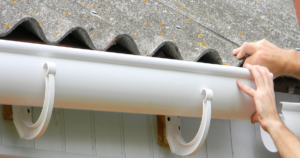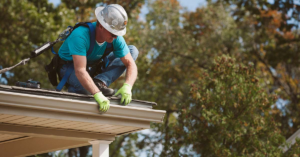Gutters are troughs installed along a building’s roofline to collect and channel rainwater. Once the water reaches the gutter, it flows down into downspouts that sit vertically on the side of the house.
Without gutters, rainwater may splash onto your siding and carry dirt, which can cause damage to your home and landscaping. Having efficient gutters is essential for keeping your home looking nice.

Rain gutters are vital in protecting your home and property from water damage. Gutters direct the rainwater that falls on your roof to a downspout channeled away from your foundation and your house. Rainwater that pools around your foundation can erode the soil and cause cracks in the foundation walls. This can be very costly to repair, and homeowners insurance typically does not cover this type of damage.
Without a functioning gutter system, the rain that falls on your roof would have no designated path to take other than straight down your walls. This could cause a lot of water damage to your home and the materials within it, including staining to windows and doors, peeling paint, rust, and mold growth. It could also lead to rotting wood framing and weaken the structure of your house.
If you don’t regularly clean your gutters, dirt and debris will build up and clog them, preventing them from being able to redirect the rainwater. This can be exacerbated by seasonal changes, with fallen leaves and seeds in the fall, and pollen and flowers in the spring. Clogged gutters can then result in overflowing, which may spill onto the side of your house and leave behind unsightly stains on your siding and windows.
Gutter cleaning can be a fairly simple task for many homeowners, but it is important to do this on a regular basis. The best time to clean your gutters is in the late fall and spring, when you can remove accumulated leaves, seeds, and pollen and make sure they are properly positioned and free-flowing. It is also a good idea to have a professional clean your gutters on an annual basis to ensure they are in good condition and still directing water away from your home.
Prevents Structural Damage
Gutters help prevent structural damage to your home by diverting water away from the foundation. Without gutters, water would simply run off the roof and pool around the foundation, causing basement flooding and cracking the foundation. Gutter systems prevent this by efficiently steering water away from the foundation, preventing soil erosion, and keeping your home structurally sound.
In addition to preventing structural damage, gutters protect your house’s siding by keeping it dry. Continuous exposure to rainwater without a proper gutter system can cause staining and mildew growth, which is not only unsightly but can also deteriorate the materials beneath it. Gutters prevent these problems by properly directing water away from your siding and into the yard or into a drainage system, far away from your home’s foundation.
Standing water around the foundation is also an ideal environment for pests, including termites and mosquitoes, to thrive. These pests are attracted to damp areas and can eat away at your foundation, leaving you with an expensive repair bill down the road. Gutters keep water away from the foundation, reducing their potential impact on your home’s structure and preventing the need for costly repairs in the future.
The key to a well-functioning gutter system is frequent maintenance, including regular cleaning and inspections of the entire gutter system. To minimize debris accumulation, homeowners should prune overhanging trees and choose species that don’t shed large amounts of leaves or twigs (deciduous trees drop leaves that are difficult to clean; evergreens release pine needles that can clog gutters). Gutters should also be inspected regularly for sagging sections and signs of leaks or corrosion. Repairing these issues quickly is essential, especially after heavy rainfall or inclement weather events.
Prevents Pests
Gutters provide a perfect habitat for pests to hide and breed. These pests include rodents, cockroaches, squirrels and snakes. Rodents can chew through the gutter system and cause damage to the house. Cockroaches love dark, moist areas and are attracted to clogged gutters where they can breed and spread around the home. Snakes can also find shelter within a clogged gutter and can gnaw through the gutter system, causing damage to the roof and threatening the safety of your family.
Pests can be prevented from taking up residence in your gutters by implementing natural deterrents and regularly cleaning the gutter system. Keeping the gutters free of rotting leaves and sticks will deter many pests, especially bees, wasps and hornets that make their nests in discarded debris. Natural deterrents like peppermint and citronella plants and essential oils can be used in combination to keep pests away from the gutters without relying on chemicals or pesticides.
The most important step in preventing pests from making their way into the gutter is to regularly clean them. Gutter cleaning services can help prevent clogging and other pest issues year round.
Another key step is to prioritize pest control in your yard. Pests are attracted to a well-maintained yard where they can easily access the property and look for food and shelter. A good lawn care program, which includes regularly mowing grass and using natural pest repellents, can drastically reduce the number of pests in your yard, reducing their ability to seek refuge in your gutters.
Prevents Foundation Damage
When water cascades off your roof, gutters help keep it away from your home’s foundation. But if your gutter system is clogged, has fallen out of place, or isn’t working at all, it can cause a number of major problems that threaten your home’s integrity and stability. For example, basement flooding during storms, cracking and buckling of your siding, paint peeling and rotting in the corner trim around windows are all possible consequences of a poorly functioning gutter system.
Even worse, foundation damage can be a serious problem when the soil surrounding your home’s foundation becomes oversaturated and shifts. This can result in cracks in the foundation, leaning walls and a weakened chimney. Gutters prevent this from happening by diverting rainwater away from the foundation, preventing soil saturation and erosion.
Gutter downspouts direct rainwater into the lawn and onto a designated area where it can be easily absorbed. This prevents standing water from pooling around your house’s foundation, preventing mold growth and avoiding the rot that comes with it. It also keeps mosquitoes at bay and allows the ground to dry, which is important in winter since freezing moisture can crack your foundation.
If you live in an area with clay-rich soil, a properly installed gutter system is crucial. Without gutters, a waterfall effect from the roof can wash away the soil near the foundation, and this causes major damage. But when the water is channeled through gutters and into a downspout, it’s far removed from your home’s foundation, preventing this type of structural damage. This is why it’s important to have a trusted contractor install and maintain your gutter system. It will make all the difference in the long run!
Prevents Damage to Your Roof
The gutter system collects water that falls off the roof, and it directs it away from your foundation. This prevents soil erosion and protects your home’s foundation. Without gutters, rainwater pools near the foundation of your house and seeps into the basement. This can cause significant and expensive damage to your home’s structure.
Gutters also safeguard your siding and paint by preventing excessive moisture and dripping water. Constant exposure to dripping water can rot the siding and discolor the paint. Gutters allow the rainwater to flow down the gutters and out of the house, reducing the risk of these problems.
A gutter system with properly functioning downspouts also helps to prevent ice dams in the winter. These dams form when melted snow and ice are unable to flow off the roof because of frozen debris. Without a gutter system, the melting snow and ice could back up onto the roof and exert pressure, leading to leaks in your roof. With gutters that effectively manage stormwater, the ice will be able to flow off your roof and into the gutters’ downspouts.
A gutter system can also serve as an irrigation system for your lawn and garden. This allows you to evenly water your plants and keeps them healthy. Gutters can be made from several different materials, including steel and vinyl. Each has its own benefits and drawbacks. Steel is a durable option but can rust in severe weather conditions. Vinyl is an inexpensive option but can fade in sunlight. It’s also best to have gutters professionally installed and inspected on a regular basis to avoid blockages and leaks. Gutters that are clogged or not functioning will cause standing water and degrade your roofing material. New gutter systems are designed to safely carry rain and melting snow away from your home before the damage can occur.







